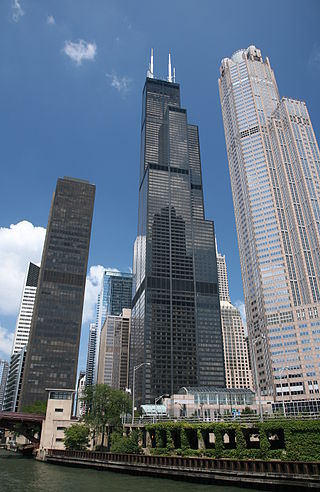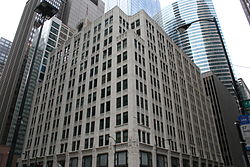
Louis Henry Sullivan was an American architect, and has been called a "father of skyscrapers" and "father of modernism". He was an influential architect of the Chicago School, a mentor to Frank Lloyd Wright, and an inspiration to the Chicago group of architects who have come to be known as the Prairie School. Along with Wright and Henry Hobson Richardson, Sullivan is one of "the recognized trinity of American architecture." The phrase "form follows function" is attributed to him, although the idea was theorised by Viollet le Duc who considered that structure and function in architecture should be the sole determinants of form. In 1944, Sullivan was the second architect to posthumously receive the AIA Gold Medal.

The Loop is Chicago's central business district and one of the city's 77 municipally recognized community areas. Located at the center of downtown Chicago on the shores of Lake Michigan, it is the second-largest business district in North America after Midtown Manhattan. The headquarters and regional offices of several global and national businesses, retail establishments, restaurants, hotels, and theaters–as well as many of Chicago's most famous attractions–are located in the Loop. The neighborhood also hosts Chicago's City Hall, the seat of Cook County, offices of other levels of government, and several foreign consulates. The intersection of State Street and Madison Street in the Loop is the origin point for the address system on Chicago's street grid.

The Merchandise Mart is a commercial building in downtown Chicago, Illinois. When it opened in 1930, it was the world's largest building, with 4 million square feet (372,000 m2) of floor space. The Art Deco structure is at the junction of the Chicago River's branches. The building is a leading retailing and wholesale location, hosting 20,000 visitors and tenants daily in the late 2000s.

The buildings and architecture of Chicago reflect the city's history and multicultural heritage, featuring prominent buildings in a variety of styles. Most structures downtown were destroyed by the Great Chicago Fire in 1871.

Chicago Union Station is an intercity and commuter rail terminal located in the West Loop neighborhood of the Near West Side of Chicago. Amtrak's flagship station in the Midwest, Union Station is the terminus of eight national long-distance routes and eight regional corridor routes. Six Metra commuter lines also terminate here.
Marshall Field & Company was an upscale department store in Chicago, Illinois. Founded in the 19th century, it grew to become a large chain before Macy's, Inc, acquired it in 2005. Its founder, Marshall Field, was a pioneering retail magnate.

State Street is a large south-north street, also one of the main streets, in Chicago, Illinois, USA and its south suburbs. Its intersection with Madison Street has marked the base point for Chicago's address system since 1909. State begins in the north at North Avenue, the south end of Lincoln Park, runs south through the heart of the Chicago Loop, and ends at the southern city limits, intersecting 127th Street along the bank of the Little Calumet River. It resumes north of 137th Street in Riverdale and runs south intermittently through Chicago's south suburbs until terminating at New Monee Road in Crete, Illinois.
Carson Pirie Scott & Co. is an American department store that was founded in 1854, which grew to over 50 locations, primarily in the Midwestern United States. It was sold to the holding company of Bon-Ton in 2006, but still operated under the Carson name. The entire Bon-Ton collection of stores, including Carson's, went into bankruptcy and closed in 2018. Bon-Ton's intellectual property was quickly sold while in bankruptcy, and the new owners reopened shortly afterwards as a BrandX virtual retailer.

The Reliance Building is a skyscraper located at 1 W. Washington Street in the Loop community area of Chicago, Illinois. The first floor and basement were designed by John Root of the Burnham and Root architectural firm in 1890, with the rest of the building completed by Charles B. Atwood in 1895. It is the first skyscraper to have large plate glass windows make up the majority of its surface area, foreshadowing a design feature that would become dominant in the 20th century.

The Historic Third Ward is a historic warehouse district located in downtown Milwaukee, Wisconsin. This Milwaukee neighborhood is listed on the National Register of Historic Places. Today, the Third Ward is home to over 450 businesses and maintains a strong position within the retail and professional service community in Milwaukee as a showcase of a mixed-use district. The neighborhood's renaissance is anchored by many specialty shops, restaurants, art galleries and theatre groups, creative businesses and condos. It is home to the Milwaukee Institute of Art and Design (MIAD), and the Broadway Theatre Center. The Ward is adjacent to the Henry Maier Festival Park, home to Summerfest. The neighborhood is bounded by the Milwaukee River to the west and south, E. Clybourn Street to the north, and Lake Michigan to the east.

The Sullivan Center, formerly known as the Carson, Pirie, Scott and Company Building or Carson, Pirie, Scott and Company Store, is a commercial building at 1 South State Street at the corner of East Madison Street in Chicago, Illinois. Louis Sullivan designed it for the retail firm Schlesinger & Mayer in 1899 and later expanded it before H.G. Selfridge & Co. purchased the structure in 1904. That firm occupied the structure for only a matter of weeks before it sold the building to Otto Young, who then leased it to Carson Pirie Scott for $7,000 per month, which occupied the building for more than a century until 2006. Subsequent additions were completed by Daniel Burnham in 1906 and Holabird & Root in 1961.

The Old Market is a neighborhood located in downtown Omaha, Nebraska, United States, and is bordered by South 10th Street to the east, 13th Street to the west, Farnam Street to the north and Jackson Street to the South. The neighborhood has many restaurants, art galleries and upscale shopping. The area retains its brick paved streets from the turn of the 20th century, horse-drawn carriages, and covered sidewalks in some areas. It is not uncommon to see a variety of street performers, artists, and other vendors.

Marshall Field's Wholesale Store, Chicago, Illinois, sometimes referred to as the Marshall Field's Warehouse Store, was a landmark seven-story building designed by Henry Hobson Richardson. Intended for the wholesale business of Field's eponymously named department store, it opened on June 20, 1887, encompassing the block bounded by Quincy, Franklin, Adams and Wells Streets, near the location of the Chicago Board of Trade Building.

The Plaza, formerly known as Evergreen Plaza, was a shopping mall in Evergreen Park, Illinois, United States. It was legally organized by Arthur Rubloff, who is also credited with coining the phrase "Magnificent Mile" describing the upscale section of Michigan Avenue north of the Chicago River to Oak Street. Rubloff secured the funding for the Evergreen Plaza from the Walgreen family who lived nearby in Beverly, Chicago. The Evergreen Plaza operated from 1952 to 2013. It featured over 120 stores, as well as a food court. The mall closed in 2013 and became an outdoor shopping center. Anchors include Whole Foods Market, and Burlington Coat Factory.

Loop Retail Historic District is a shopping district within the Chicago Loop community area in Cook County, Illinois, United States. It is bounded by Lake Street to the north, Ida B. Wells Drive to the south, State Street to the west and Wabash Avenue to the east. The district has the highest density of National Historic Landmark, National Register of Historic Places and Chicago Landmark designated buildings in Chicago. It hosts several historic buildings including former department store flagship locations Marshall Field and Company Building, and the Sullivan Center. It was added to the National Register of Historic Places on November 27, 1998. It includes 74 contributing buildings and structures, including 13 separately listed Registered Historic Places, and 22 non-contributing buildings. Other significant buildings in the district include the Joffrey Tower, Chicago Theatre, Palmer House, and Page Brothers Building. It also hosts DePaul University's College of Commerce, which includes the Kellstadt Graduate School of Business and the Robert Morris College.

Randhurst Village is a shopping center located at the corner of Rand Road and Elmhurst Road in Mount Prospect, Illinois. The shopping center took its name from combining the names of these two roads into a portmanteau.
Currently there are 124 properties listed on the National Register of Historic Places in Central Chicago, out of more than 350 listings in the City of Chicago. Central Chicago includes 3 of the 77 well-defined community areas of Chicago: the historic business and cultural center of Chicago known as the Loop, as well as the Near North Side and the Near South Side. The combined area is bounded by Lake Michigan on the east, the Chicago River on the west, North Avenue on the north, and 26th Street on the south. This area runs 5.25 miles (8.45 km) from north to south and about 1.5 miles (2.4 km) from east to west.

The Austin, Nichols and Company Warehouse, also known as 184 Kent Avenue and Austin Nichols House, is a historic warehouse building on the East River between North 3rd and North 4th Streets in Williamsburg, Brooklyn, New York City. The structure, measuring 179 by 440 feet, is one of the city's few structures built in the Egyptian Revival style. The building was designed by architect Cass Gilbert and erected by general contractor Turner Construction with the help of structural engineer Gunvald Aus.

The Starrett–Lehigh Building is a 19-story building at 601 West 26th Street, occupying the full block between Eleventh Avenue, 26th Street, Twelfth Avenue, and 27th Street, in the Chelsea neighborhood of Manhattan in New York City. It was built between 1930 and 1931 by the Starrett Corporation and the Lehigh Valley Railroad (LV), who formed a joint venture to develop a freight terminal and warehouse to replace the railroad's previous freight terminal. The structure was designed by the firm of Cory & Cory, with Yasuo Matsui as the associate architect and the firm of Purdy & Henderson as the consulting structural engineers. The Starrett–Lehigh Building has largely been used as an office building since the late 1990s.

Edens Plaza is a strip mall in the town of Wilmette, Illinois. It was built by Carson Pirie Scott & Co. (Carson's) in 1956, and, until 2018, was anchored by one of their stores. It is located on a triangular parcel of land between Lake Avenue, Skokie Boulevard and the Edens Expressway.




















